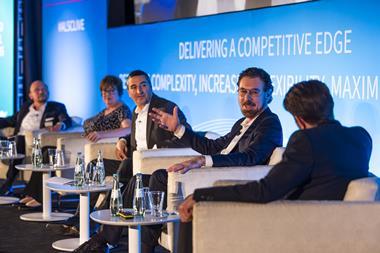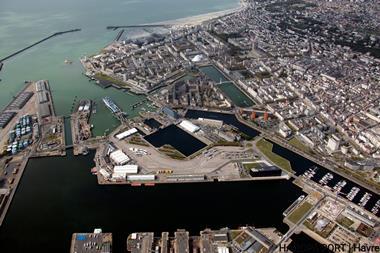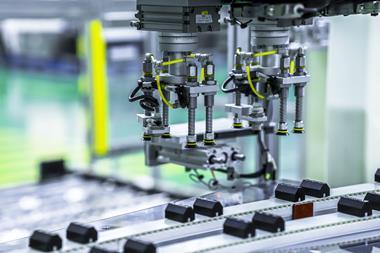
Marcia MacLeod reports on what suppliers and logistics providers in the Turkish market are doing to localise automotive production and improve logistics costs for the total supply chain
Turkish automotive production is growing again, with opportunities in logistics for both established third-party logistics providers and new entrants to the country. Turkey’s ancient designation as the bridge between Asia, Europe and the Middle East appears never to have been more relevant for automotive, with manufacturers and tier suppliers increasingly using it as a base for exports.
 In 2011, Turkey produced approximately 900,000 vehicles – 600,000 passenger cars and 300,000 light commercial units. This year, finished vehicles are predicted to top the million mark, although commercial units will drop slightly. “We are challenging the top five vehicle producing countries in Europe,” boasts Altan Aytac, supply chain director at Tofas a joint venture between Italy’s Fiat and Turkey’s Koç Holding. “We are very close to Spain, which currently sits at number five.”
In 2011, Turkey produced approximately 900,000 vehicles – 600,000 passenger cars and 300,000 light commercial units. This year, finished vehicles are predicted to top the million mark, although commercial units will drop slightly. “We are challenging the top five vehicle producing countries in Europe,” boasts Altan Aytac, supply chain director at Tofas a joint venture between Italy’s Fiat and Turkey’s Koç Holding. “We are very close to Spain, which currently sits at number five.”
The growth comes as a welcome boost to an industry which has slumped since a peak of 1.2m vehicles produced before the recession. OEMs are increasing capacity and suppliers are strengthening their Turkish presence or entering the market. Most tier one suppliers have factories or assembly plants in the country, and many are exporting Turkish parts throughout Europe and beyond. Ford Otosan, for example, is increasing light commercial vehicle capacity over the next two years from 330,000 to 400,000.
Automotive is so important to the economy that it is driving public logistics policy. The government has joined with the Turkish Automotive Production Association (OSD), which includes OEMs and suppliers, to develop logistics and infrastructure projects.
“The Marmara Region Logistics Infrastructure Project is intended to improve logistics to meet future needs,” explains Aytac. “We expect production to reach 2m vehicles by 2023. Ports such as Gemlik need to be improved and expanded to meet this demand, as does road and rail provision.”
Global tier suppliers are also paying close attention to the government’s plans. “We need to build regional logistics hubs,” adds Taner Basa, manager of logistics and commercial coordination at Bosch Turkey. “Plans have been confirmed for the first logistics villages near Istanbul and in Bursa [where Bosch has a factory along with Tofas and Renault].”
Logistics providers look to grow
The Turkish authorities are also viewing logistics in general as increasingly important. The government has set targets of growing logistics’ share of GDP from 4% to around 11%. By 2025, it hopes logistics services will account for around $70 billion annually.
 Logistics service suppliers are interested in the Turkish market, but for some, it may be too late: Turkey’s 3PL sector is already mature and very competitive. Most of the major players, including Ceva Logistics, DB Schenker, DHL, Gefco, UTi, Hellman Worldwide, Hanjin Logistics and Kuehne+Nagel, are active in the market, while there is also a choice of good local service providers, such as Ekol and Barsan. However, new entrants continue to try their luck.
Logistics service suppliers are interested in the Turkish market, but for some, it may be too late: Turkey’s 3PL sector is already mature and very competitive. Most of the major players, including Ceva Logistics, DB Schenker, DHL, Gefco, UTi, Hellman Worldwide, Hanjin Logistics and Kuehne+Nagel, are active in the market, while there is also a choice of good local service providers, such as Ekol and Barsan. However, new entrants continue to try their luck.
NYK subsidiary Yusen Logistics, for example, launched its Turkish operation earlier this year. “We have always been active in the region and wanted to open our own operations in 2007,” explains Jeremy Davidson, managing director of Yusen in Turkey and deputy managing director of Yusen Logistics Europe. “Unfortunately, the recession stopped all investment, but we have now set up shop in Turkey, serving a number of our existing automotive customers, such as Renault, Nissan and Toyota.”
Davidson hopes that by having a base in the country, Yusen Logistics can bring its inbound logistics experience to production plants there. So far, the provider handles only export material traffic out of Turkey.
Most imported material for production in Turkey comes from Europe, partly because the European headquarters of OEMs usually carry out buying centrally, with imports from the Far East or the Americas often consolidated on the continent. Germany, France, Italy and eastern European countries such as the Czech Republic and increasingly Poland provide most imported parts, although a small number come out of the Far East, particularly China. Most OEMs claim that only half their parts are imported; the rest are sourced from the growing local supply base.

Although road has historically been the dominant mode of transport for European imports, there is more focus on multimodal transport as trucking proves unreliable and more expensive. “Earlier this year, we implemented a strategy to be less dependent on road and to use more rail and sea freight, changing our logistics partner to meet this goal,” emphasises Baris Melek Dogan, supply chain manager at Avon Automotive. “Rail and sea should give us a better, more flexible service with guaranteed lead times, which may be shorter than road, too. Road transport is too often held up by the weather, strikes and other delays.”
A survey of automotive manufacturers reveals a variety of different modes employed for the import supply chain. Tofas Fiat relies heavily on sea freight, running a weekly direct service from Genoa to Gemlik (near Bursa) in conjunction with Arkas Group, a local transport company. “We run two ships non-stop to Turkey, carrying 50-55 containers per sailing,” explains Aytac. “The transit is just four or five days, although it takes much longer going back from Turkey because it stops at more ports.”
However, 20% of Tofas Fiat’s imports move by road. “Certain parts like engines and gear boxes are crucial and lead times are more important. We send these by ro-ro from Bari to Gemlik, which takes three or four days. We also use road from other countries, such as Poland.”
Ford Otosan receives most of its shipments by rail. “Parts are consolidated in Cologne,” explains Guvan Ozyurt, head of logistics and planning. “These are sent on a daily block train to a station just 20km from our factory. We began the block train in 2005 as we expanded capacity and imported greater volumes. We find it stable, consistent and cheaper than road. Even though it crosses seven borders, it takes just six-and-ahalf days.”
The company is now planning trials of an intermodal service combining rail and sea: rail from Cologne to Trieste and sea from Italy to Turkey. Trials are due to start next year. Transfesa and a local rail company control the rail services.
Yusen Logistics is also looking at using short-sea services from Trieste or Marseilles because of the “unpredictability” of rail, according to Davidson.
But the focus on multimodal logistics has not yielded positive results for everyone. Bosch Turkey has been disappointed with its rail experiments. “We tried moving cargo by rail from France and Germany to the nearest suitable ports for transhipment to sea, but it wasn’t good enough,” says Basa. “There were too many delays on the rail network, so we missed our sea connection. We don’t have the volume to run block trains or have a regular contract with a short-sea carrier, like some OEMs do.
 “Intermodal is being discussed in the Turkish automotive sector,” he adds. “But while it’s attractive cost-wise, it brings a lot of headaches, especially in terms of safety. There are security issues for rail freight in Romania and Bulgaria, for example.”
“Intermodal is being discussed in the Turkish automotive sector,” he adds. “But while it’s attractive cost-wise, it brings a lot of headaches, especially in terms of safety. There are security issues for rail freight in Romania and Bulgaria, for example.”
Most 3PLs also favour road for European movements, but this might change. Although road infrastructure is being improved, significant developments in the rail and port sectors could well encourage more people to try new routings.
“Rail is not developed in Turkey, so we use road transport,” points out Aslan Uzon, managing director of Ceva Logistics in Turkey and the Balkans. “Rail from Europe takes six or seven days, so it’s only suitable for non-urgent shipments. There are also no return loads, which makes it more expensive. But our rail shipments have gone from 0 to 30% in five years and we expect it to increase to 50% as the network develops.”
The Turkish government is privatising the railways, which is expected to lead to a connection between Bursa and the national rail network, as well as more links to continental European railways. High-speed rail is being extended, too. The first phase of the privatisation and network connection is already taking place for passengers. It is expected that when private companies are in place, they will cater for freight, too.
“There are also plans to build a rail bridge under the Bosphorus Sea,” points out Fulvia Villa, managing director of Gefco Turkey. “The Marmaray Project will connect Turkish railways with those in Europe and Asia. It was meant to be finished by now, but work is still going on. At the moment, rail freight has to cross the sea by ferry. Even when it is built, priority will be given to passengers; freight will have to travel at night.”
The tunnel is meant to relieve severe road congestion around Istanbul. All traffic going between the ‘European’ side, where most businesses are located, and the ‘Asian’ side, where the largest residential areas are located, has to cross the Bosphorus Strait, which wastes time and fuel, adds to air and noise pollution, and leads to an increase in traffic accidents.
It’s not just the Bosphorus and lack of connections that cause problems, though. “The rail system in Turkey is not sufficient in terms of accessibility,” says Murat Akyildiz, manager of client services, automotive, for UTi in Turkey. “Rail yards are not well spread out through industrial zones. If the final destination is more than 100km from the rail yard, it’s not worth using rail freight.”
 The government hopes its privatisation plans will open up the rail freight market to local and international train operators, lead to the construction of new rail and road connections linking Turkey’s ports to the hinterland, and encourage the development of more logistics centres.
The government hopes its privatisation plans will open up the rail freight market to local and international train operators, lead to the construction of new rail and road connections linking Turkey’s ports to the hinterland, and encourage the development of more logistics centres.
“Turkey’s transport strategies have been revised,” says a report on the Marmaray project. “Current transport policy now recognises the importance of a strong rail freight capability.”
“A reliable rail connection could help stabilise the supply chain,” agrees Dr Jens Möller, senior vice-president of global automotive for UTi. “Due to the long distances involved, the road-based supply chain is vulnerable. I would like to see the promised infrastructure improvements happen. The infrastructure needs to be built up to cater for growth.”
Investing in Turkey’s ports and transport nodes
Planned infrastructure developments include a rail ‘silk road’ from west to east, as well as a number of port expansions. A new Mersin Container Port, which will sit alongside the existing port of Mersin, is conceived as a ‘gateway’ to serve Ankara, eastern Turkey and neighbouring countries. The first phase, to open in 2014, will have a 1.9m TEU capacity; when the fifth and final stage is completed in 2033, the port will be able to handle 11.4m TEU. Rail connectivity is included in the plans from the start.

Iskenderun is also due to be developed with support from InfraMed, the long-term infrastructure investment fund dedicated to the southern and eastern Mediterranean region. A 55,000-square-metre terminal, a fifth of which is earmarked for warehousing, will be constructed to provide a 250,000 TEU facility. Assan Port Iskenderun, as it will be called, will be able to cater for the largest container ships in operation. A second phase will increase capacity to 400,000 TEU. Further land will be reclaimed for logistics operations and a rail terminal will comprise two tracks connecting the port to the rest of the country.
Supporters say that the Northern Aegean Container Port at Candarli, near Izmir, will be among the world’s ten largest ports when it opens next year. It will be able to accommodate six megaships simultaneously, have a 12m TEU capacity and be rail connected.
While its backers admit that the country’s road and rail infrastructure is not yet good enough to cope with the extra traffic the port will generate, they say that hinterland connections will be improved along with the growth of the port.
Road is not being ignored, though. An $11 billion highway linking Istanbul with Izmir is on the cards, to include the world’s second longest suspension bridge, while another one from Ankara to Nigde is also planned. Turkey is part of the Trans-European Motorway Network, which is being expanded to connect the south of Turkey with the east of the country.
A third Istanbul airport is planned on the north side of the city, too – and it couldn’t come soon enough. “The airport is overcrowded, leading to lots of delays,” says Bosch’s Basa. “There is not enough capacity.”
Most automotive imports from the Far East or North America are sent by sea. Although there are services calling direct in Turkey, often the shipper’s volumes are not big enough to make it worthwhile. Many consignments are consolidated at the parent company’s European headquarters before delivery by road, rail or short-sea.
Lack of volume also contributes to the growth in lessthan- truckload shipments. “We’re shipping more LTLs,” admits Avon’s Dogan. “We import from six countries, but five of our suppliers send LTLs. There has not been sufficient consolidation among tier ones to create FTLs [full truckloads]. However, a lot of the time it depends on our 3PL and on our customer.”
Bosch Turkey uses two logistics service suppliers: Barsan to handle FTLs and Ekol for LTL shipments. “It’s all down to pricing,” Basa emphasises. “But although we want to reduce LTL shipments, we see more of them than before. We have, however, convinced two suppliers in the Czech Republic to consolidate our orders into one FTL.”
Although air freight is usually only used for urgent shipments, Bosch Turkey has also begun to consider the mode for more regular shipments. “We find sometimes if volume is low – say one or two pallets – it is cheaper to send it by air from South Korea than by sea,” Basa explains. “Even if it is the same price, it is quicker.”
Whichever way the cargo enters Turkey, it has to go through customs. Trade agreements with the EU mean that, providing paperwork is correctly completed, European imports are mostly, but not entirely, cleared without any significant problems or delays at the border.
However, those from outside Europe can still be mired in bureaucracy. “It normally takes one day to clear non-European goods,” says Gefco’s Villa, “but it can take two, three or even four days. People need to double-check their operations and their documentation, and know which customs office they are going to go through.”
Turkey’s customs procedures are technologically behind other countries. “Customs still demands a lot more paperwork than in Europe or the US,” agrees UTi’s Akyildiz. “Off-loading vehicles takes more time, since all cargo in an LTL shipment must be cleared at the same time. Service providers struggle to achieve the desired number of trips. For example, a trailer moving between Scandinavia and Turkey would only manage two round trips per month.”
But Akyildiz adds that electronic documentation is being implemented and should ease import processes. “In addition, some new customs entry points are being opened along the borders with Iraq, Iran and Georgia,” he says.
Making logistics easier in Turkey
The Turkish government is well aware that formalities must be streamlined and processes made more efficient if Turkey is to capitalise on its location as the bridge between Europe and Asia. More and more Turkish automotive companies are exporting both parts and finished vehicles. Part suppliers have a tremendous opportunity to feed the automotive world.

“[Bosch Turkey] volumes have increased three or four times over the last four years,” Basa boasts. “Manufacturing costs are lower, there are more suppliers here and the growth in logistics has made it easier to operate. Business with the Middle East is rising; we are responsible for Bosch in Iran, for example. But things have to improve further on the import side: we cannot accurately forecast stock arrival, so stock management becomes a big issue and we have to keep buffer stockholdings.”
OEMs are exporting a large amount, too. Ford Otosan is sending Turkish-made commercial vehicle parts to Russia, South America, Romania and North America, although the export business is outsourced to a third party. “DHL handles this for us,” explains Ozyurt. “We have a dedicated area in their warehouse, which is near our plant.
The growth in import and export is also good news for logistics companies. “When the promised infrastructure developments are finished, more logistics capacity will be needed and more added value will be required, too,” UTi’s Moeller points out. “Suppliers may ask us to assemble parts, for example. We could do sequencing and kitting. We will be replicating the solutions suppliers and OEMs already enjoy in more mature markets, with the same compliance, reliability and professionalism they have come to expect.”






















